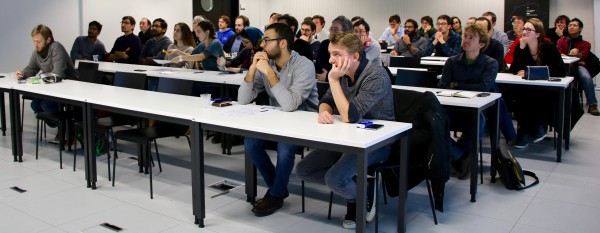MARVEL Junior Seminar — June 2017
The MARVEL Junior Seminars aim to intensify interactions between the MARVEL Junior scientists belonging to different research groups located at EPFL. The EPFL community interested in MARVEL research topics is very welcome to attend. We believe that these events will be central for establishing a vibrant community.
Each seminar consists of two presentations of 25 minutes each, allowing to present on a scientific question in depth, each presentation being followed by 10 minutes for discussion. The discussion is facilitated and timed by the chairperson of the day whose mission is to ensure active lively interactions between the audience and the speakers.
Pizza is served as of 11:45 in the MED hall (floor 0), and after the seminar at 13:30 you are cordially invited for coffee and dessert to continue discussion with the speakers.

MARVEL Junior Seminar Organizing Committee — Ariadni Boziki, Francesco Ambrosio, Fernando Gargiulo, Sandip De, Gloria Capano, Michele Pizzochero, Quang Van Nguyen, Kun-Han Lin and Nathalie Jongen
Check the list of the next MARVEL Junior Seminars here.
Abstract — Redox levels in aqueous solution: theory and applications - Francesco Ambrosio
We investigate redox levels in aqueous solution using a combination of ab initio molecular dynamics (MD) simulations and thermodynamic integration methods. We provide a formulation in analogy to the definition of charge transition levels for defects in crystalline materials. The redox levels calculated as a function of the fraction α of Fock exchange are found to remain constant, reproducing a general behavior previously observed for charge transition levels of defects. We hence use this method to provide a consistent description of the electronic levels associated with localized and delocalized excess electrons in liquid water. The excess electron localizes in a cavity with an average radius of 1.8 Å and a majority coordination of five water molecules. The vertical binding energy, the optical s–p transitions, and the adiabatic redox level are found to agree closely with their experimental counterparts. The energy level associated with electron delocalization V0 is inferred to lie at −0.97 eV with respect to the vacuum level.
Abstract — High-throughput search for novel Li-ion solid-state conductors - Leonid Kahle
The development of safer batteries is essential to our transition to emission-free electric vehicles.
Solid state electrolytes are the best candidate to replace volatile and flammable liquid electrolyte used in state-of-the-art lithium-ion batteries, but to the present day we lack a structure that is both electrochemically stable and has a high ionic conductivity.
To understand, characterize and quantify ionic transport, first-principles molecular dynamics (FPMD) in the DFT framework have shown to be a powerful tool.
However, to find new candidate electrolytes in materials databases, FPMD is computationally too expensive for a high-throughput screening.
To reduce the computational cost, we exploit the different electronic properties of the host lattice and the diffusion lithium ions.
This novel, so-called pinball model, treats the effect of host-lattice displacements as a perturbation to the equilibrium electrostatic potential that scatters lithium ions.
We compare our model with FPMD for several Lithium-ion conductors to discuss the accuracy of the model, and illustrate how this model can be applied to a large-scale screening of materials databases.
Low-volume newsletters, targeted to the scientific and industrial communities.
Subscribe to our newsletter